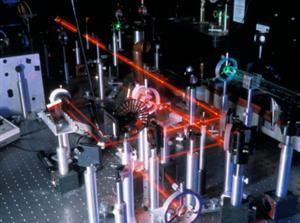| Complexity level: | 9 |
| Time required: | 1 hour to prepare, 1 hour for observation |
| Material availability: | Easily obtained from a hobby store |
| Safety concerns: | The colored glass will filter and block the beam of the laser pointer. |
Hypothesis
The colored glass will filter and block the beam of the laser pointer.
Overview
Laser
Light Amplification by Stimulated Emission of Radiation (Laser) is a device that will emit electromagnetic radiation in the form of visible light by the process of stimulated emission. The light that is emitted by the laser device is monochromatic, which means it has a specific wavelength. Laser light is also coherent because the photons are launched in a uniform wave front. It also has low divergence and the beam is extremely concentrated.
Laser light is produced by pumping the atoms of the lasing medium with electrical discharges or light flashes. The electrons in the atom will gain energy, become excited and move one or two energy levels higher. However, these electrons will not remain at an excited state for long and they will return to their original state by releasing a photon (ie: light energy). The amount of energy emitted by the excited electrons when they return to a relaxed state, will determine the wavelength of the light.
Scientific Terms
Materials
The materials required for the experiment:
- A 1 watt red laser pointer
- A 1 watt green laser pointer
- A 1 watt blue laser pointer
- A holder for the laser pointer
- A red glass filter
- A green glass filter
- A blue glass filter
- A watt-meter
- A solar cell
- A 1-meter ruler
Procedure
1. For this experiment, the independent variable is the color of the glass filter (red, green and blue) and the color of the laser pointer – red, green and blue. The dependent variable is the amount of power of the laser beam. This is determined by using a solar cell to measure the power of the light. The constants (control variables) are the distance of the colored glass filter and the solar cell from the laser pointer.
2. The red laser pointer is mounted on the holder. The solar cell is connected to the watt meter and placed 1 meter away from the laser pointer. The laser pointer is turned on and aligned to point to the center of the solar cell. The power reading of the solar cell is recorded in the table given below.
3. Procedure 2 is repeated with the green and blue laser pointers. The wattage measurements are recorded in the table given below.
4. Procedures 2 and 3 are repeated, this time with the inclusion of the glass filters. The red, green and blue colored glass filters are each placed at a distance of 500mm between the laser pointer and the solar cell. The wattage readings are measured and recorded in the table given below.
Results
It is observed that the red, green and blue colored glass filters did not have any significant impact on the power of the laser beam. It is also observed that the red laser beam emitted the greatest amount of power and the blue beam, the least amount of power.
| Glass filter color | Power of the laser light through the glass filter (Watt) | ||
| Red laser | Green laser | Blue laser | |
| None | 0.88 | 0.65 | 0.35 |
| Red | 0.88 | 0.64 | 0.34 |
| Green | 0.87 | 0.62 | 0.31 |
| Blue | 0.87 | 0.64 | 0.33 |
Conclusion
The hypothesis that colored glass will filter and block the laser pointer beam is disproved. The laser beam is monochromatic because it has a very narrow band of light wavelength. If the color of the glass filter does not match the wavelength of the laser beam, it will not affect the power of the laser beam.
The laser was invented in the 1960s and it has found applications in defense, medicine, consumer products, industrial applications, entertainment and research. Bar code scanners used in supermarkets, laser printers and CD players all use laser technology. The laser is also used in medicine for surgery, eye treatment, skin treatment and dentistry. Lasers are also used in various industries for cutting and welding and they are also used by law enforcement agencies and the military to mark targets and guide munitions.
Also consider
Try to repeat the experiment by using other color laser pointers like yellow or orange colors.
The experiment can also be done by passing the laser through a beaker filled with colored solution.
References
Laser - http://en.wikipedia.org/wiki/Laser
How lasers work - http://science.howstuffworks.com/laser3.htm

